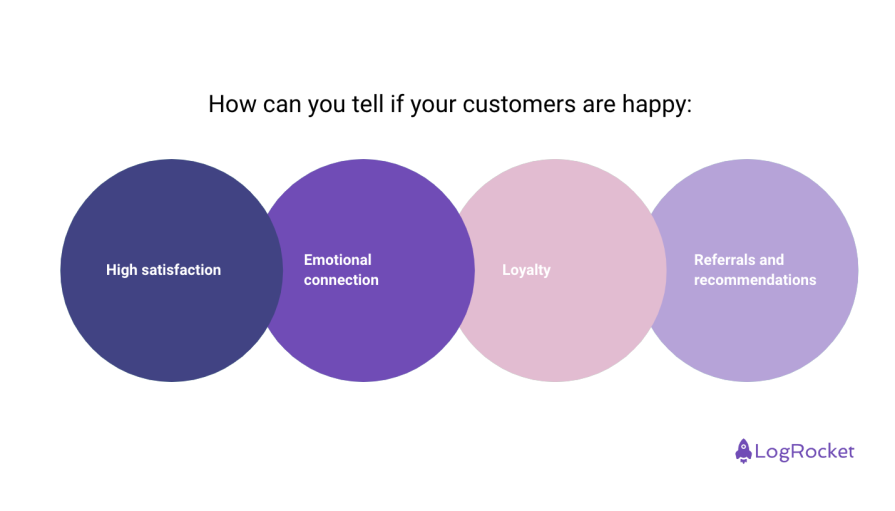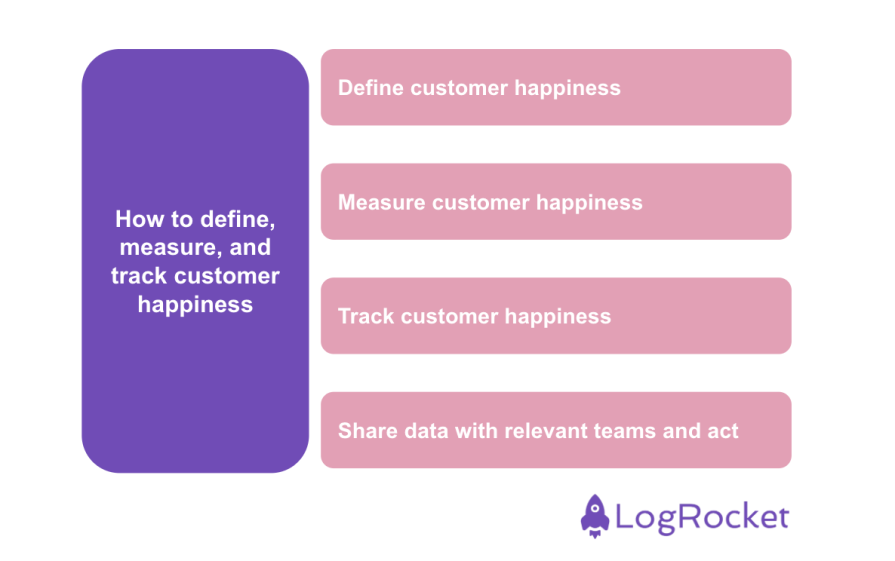The customer is the king or so the saying goes, right? This very much still rings true today. Especially in customer-driven industries, you cannot afford to overlook the power of happy customers.

Customers are the lifeblood of any successful company, acting as loyal brand advocates, driving repeat business, and fueling positive word-of-mouth marketing, but cultivating customer happiness goes beyond a simple adage like “the customer is king.” It requires a strategic investment and focus on understanding customer needs, crafting exceptional experiences, and fostering genuine loyalty.
This article takes a deep look into the various strategies you can employ to cultivate a happy customer base. By implementing these strategies, you can turn satisfied customers into loyal brand ambassadors, ultimately driving sustainable business growth.
A happy customer is no longer just someone who gets what they pay for — the bar is far higher today. A happy customer is an enthusiastic advocate for your brand, a loyal repeat customer, and a source of positive word-of-mouth marketing and influence.
As Zappos founder Tony Hsieh famously stated, “delivering happiness” is a core principle for building a successful business, such that for Zappos:
“Over the years, the number one driver of our growth at Zappos has been repeat customers and word of mouth. Our philosophy has been to take most of the money we would have spent on paid advertising and invest it into customer service and the customer experience instead, letting our customers do the marketing for us through word of mouth.”
At this point, you might be asking yourself what exactly makes a customer a “happy” one? Here’s a breakdown of key attributes you’ll find with every happy customer:

This is the foundation of customer happiness. It means meeting or exceeding a customer’s expectations regarding the product’s functionality, usability, quality, and value proposition. Satisfied customers are more likely to repurchase, but this isn’t the only essential element for customer happiness.
Happy customers feel a positive association with your brand. If your customers aren’t raving about your products and services at every opportunity, then you aren’t in business. This can stem from a positive customer service experience, a sense of community fostered by the brand, or simply feeling understood and valued.
A happy customer goes beyond satisfaction and becomes a loyal advocate. They choose your brand over competitors, readily recommend your products to others, and are more likely to forgive occasional missteps.
Happy customers become your biggest fans! They tell their friends, family, and even strangers online how much they love your business. This means more customers for you, with less effort needed to convince them.
Here are some general examples of happy customers in action:
Customer happiness, as you’ve seen, is a key driver of business success, but can be a complex concept to quantify. However, by implementing a combination of metrics and strategies, you can gain valuable insights into your customers’ happiness and identify areas for improvement. Here’s a breakdown of how to define, measure, and track customer happiness:

To define your customers’ happiness with your business, it’s important to focus on the entirety of the customer experience across all touch points. Any exercise to measure and track customer happiness should encompass the entire customer journey, from the first point of contact, initial interaction, engagement, to ongoing support.
Here are four key metrics to measure customer happiness:
This allows you to identify trends, measure the impact of changes you make, and ensure your efforts to improve customer experience are paying off. By consistently monitoring and analyzing customer happiness data, customer-driven you can make better-informed decisions to cultivate a loyal and happy customer base. Do this by:
The data you gather on customer happiness is only valuable if it’s used to make positive changes. Here’s how to turn those insights into action:
Happy customers translate to positive reviews, repeat purchases, and a healthy retention rate. The question remains — what can you do to go beyond basic satisfaction? This section will provide strategies that elevate happy customers to loyal brand advocates, the kind who become your biggest cheerleaders.
It all starts with what customers see when they first interact with your brand or product. Here’s where your design partners come in — design a unique and user-friendly interface with intuitive navigation, and clear information architecture for a seamless experience. Conduct A/B testing on different design elements (layout, button placement) to see which version leads to higher user engagement. Use clear and concise language, with visuals that accurately represent your product or service.
With your marketing and advertising materials, highlight the value proposition of your product or service in a way that resonates with your target audience. This should speak directly to your ideal customer’s needs and pain points. You can also highlight customer testimonials and success stories to build trust and credibility from the get go.
Your onboarding must offer a smooth and hitchfree process that guides prospects and new users through the initial setup and product exploration, ensuring a positive and frustration-free experience. Implement interactive tutorials or guided tours to familiarize new users with key features. Offer in-app contextual help messages or tooltips to answer common questions.
Gather customer feedback early and continually through surveys, user interviews, social media monitoring, sentiment analysis and other tools to understand customer needs and pain points. Embed short surveys after key user interactions (e.g., successful purchase, task completion) to gather real-time contextual feedback. Dedicate resources to run periodic in-depth user interviews to gain qualitative insights on any issues highlighted and opportunity signals seen.
Act on this feedback promptly and transparently. This’ll demonstrate your commitment to customer concerns by addressing their feedback in a timely manner and keeping them informed about any actions you’re taking. This could involve reaching out to customers directly for clarity or more details, immediately after their feedback is received. Use this customer feedback to prioritize your product roadmap features and bug fixes. A less used, but sticky strategy is to publicly acknowledge and address negative feedback on social media and then communicate with users about changes implemented based on their feedback.
Prioritize customer experience across all touchpoints, such that every interaction with your brand, from marketing and sales to customer service and support, should contribute to a positive customer experience. Conduct and document customer journey mapping to identify potential pain points or friction in the user experience. With insights from this exercise, further invest in UX research to optimize the relevant touchpoints and features to improve the overall user journey.
Encourage frontline employees to share their insights and ideas for product improvement and service enhancements. This could involve organizing regular workshops where customer-facing teams like sales and support can share their insights with product managers, designers, engineers, etc. These brainstorming sessions should focus on triaging, investigating, analyzing, and resolving (at scale) specific customer pain points identified through feedback.
Implement customer feedback loops to democratize insights and feedback beyond your team. Create a system where customer feedback is easily captured and routed to relevant teams (product, engineering, marketing) for consideration and implementation.
Offer multiple support channels that provide a variety of ways for customers to reach support, including phone, email, chat, and social media.
This starts by empowering your customer service and support teams by providing them with the resources and training they need to effectively resolve customer issues and go the extra mile to ensure happiness. Ensure your support team understands your product or service thoroughly and possesses strong communication and problem-solving skills.
Focus on delivering positive interactions at every touchpoint. Your support team should be empowered to go beyond basic issue resolution. Instead, encourage them to actively listen to customer concerns and offer personalized solutions that create positive, memorable experiences for customers.
Train your staff on phone etiquette and active listening. Take measures to ensure that phone conversations are professional, courteous, and focused on addressing customer needs effectively.
Use customer data (purchase history, preferences) to personalize interactions whenever possible and provide relevant recommendations. You should definitely also use your customers’ names during phone conversations and email exchanges.
Treat every interaction as an opportunity to build brand loyalty. This involves going the extra mile to exceed expectations and leave a lasting positive impression on customers. For example, you can empower support and operational staff to offer unexpected delights like birthday greetings or small freebies to exceed customer expectations. Finally, follow up with customers after service interactions to ensure their issue has been resolved to their satisfaction.
At this point, you might be saying to yourself, great, but how do these strategies translate into real-world action? To that end, let’s take a closer look at how companies cultivate happy customers across different industries.
For saturated industries with many similar offerings, customer experience is a core differentiator, a positive and memorable customer experience is what sets them apart from the competition. These typically include the businesses in:
For industries where building trust and loyalty is crucial for customer retention and recurring business. This includes:
For industries with frequent direct customer interaction, which allows for building rapport and addressing concerns promptly. This includes:
This article provides a roadmap for businesses to cultivate happy customers, ultimately driving sustainable business growth. Here are the key takeaways:
By analyzing a combination of these metrics, you can gain a comprehensive understanding of customer happiness. Regularly track these metrics over time to identify trends and measure the effectiveness of customer experience improvement initiatives. Remember, the goal isn’t just to collect data, but to act on it by addressing customer pain points and implementing solutions to create a more positive and sustainable customer experience.
Featured image source: IconScout

LogRocket identifies friction points in the user experience so you can make informed decisions about product and design changes that must happen to hit your goals.
With LogRocket, you can understand the scope of the issues affecting your product and prioritize the changes that need to be made. LogRocket simplifies workflows by allowing Engineering, Product, UX, and Design teams to work from the same data as you, eliminating any confusion about what needs to be done.
Get your teams on the same page — try LogRocket today.

A practical framework for PMs to use AI in ideation without sacrificing judgment, strategy, or decision quality.

A practical five minute revenue estimation method to help product managers compare ideas, drop low impact features, and prioritize smarter.

A practical guide for PMs who want to stop being bottlenecks, delegate smarter, and lead teams effectively with a clear ownership framework.

Stop letting unreliable data block features. Treat data as inventory to track quality, ownership, and ship with confidence.